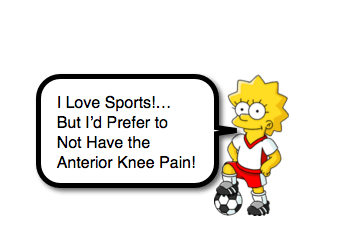Patellofemoral Pain Syndrome and Anterior Knee Pain

Patellofemoral Pain Syndrome: Basics
- The knee is bears a significant load during all activities.
- The patella facilitates force of knee extension. [Houghton, 2006]
- The patella also protects the patellar tendon from friction.
- Patellofemoral Pain Syndrome is one of the most common causes of anterior knee pain in the primary care arena. [Yin, 2016; Pengel, 2014; Houghton, 2006]
- Cause is multifactorial and varies between individuals. [Finlayson, 2014; Houghton, 2006]
- Patellar malaignment
- Larger Q angles associated with increased static patellofemoral joint stress.
- Quadricep weakness (especially vestus medialis) also contributes to improper tracking of patella.
- Mechanical overload of joint
- Excessively jumping, running, etc.
- Additionally, hip muscle weakness can increase load on the knee (the hip muscles can absorb up to 25% of the load that occurs during landing).
- Decreased flexibility.
- Inflexible muscles/tendons are less able to absorb eccentric loads .
- Quadriceps, hamstings, hip flexors, gastrocnemius, and other soft tissues of the lower extremities all influence the patellofemoral joint.
- Regional inflammatory changes.
- Patellar malaignment
- Epidemiology:
- Affects females > males [Stracciolini, 2014; Houghton, 2006]
- More commonly seen in adolescents. [Pengel, 2014]
- May be related to activity, but also seen without specific activity.
- Can be unilateral or bilateral.
Patellofemoral Pain Syndrome: Presentation
- Typically have poorly localized complaint of knee pain (“Knee Grab Sign“). [Pengel, 2014]
- Dull and achy pain during and after activity. [Houghton, 2006]
- Worse with weight bearing sports, squatting, or climbing stairs.
- Also exacerbated upon standing after sitting for awhile.
- Patient may report a sensation of “giving way,” but there is no joint instability.
- Occurs with ascending or descending stairs or an incline.
- Meniscal / ligamentous injury leads to instability and apprehension with pivoting or twisting movements.
- On exam may have tenderness over:
- Medial and/or lateral patellar facets
- Superior and inferior poles of the patella
- Pain over the physes or joint line is NOT normal for patellofemoral pain. [Houghton, 2006]
Patellofemoral Pain Syndrome: DDx
- Always consider the following:
- Patellar Instability / Subluxation / Dislocation
- Osgood-Schlatter’s Disease
- Osteochondritis Dissecans
- Idiopathic lesion of the bone and cartilage
- Leads to bone necrosis
- Can lead to separation of the articular cartilage!
- Referred Pain
- Oncologic Process
- Osteochondroma
- Ewing’s Sarcoma
- Osteosarcoma
- Leukemia
- Neuroblastoma metastases
- The history and exam may be encouraging, but persistent pain warrants consideration for more ominous issues and, thus, images may be warranted.
Patellofemoral Pain Syndrome: Management
- Educate and Reassure
- Do not dismiss as “growing pains.”
- Generally, gradual improvement and resolution of symptoms can be achieved. [Houghton, 2006]
- Activity Modification
- Reduce impact exercises
- Avoid running and jumping sports.
- Reduce activities that load the knee
- Avoid squatting exercises and sports (not good to be a catcher in baseball).
- Reduce impact exercises
- Increase Flexibility
- Particularly hamstrings, quadriceps, iliotibial band, and gastrocnemius.
- We all could stand to be more flexible (in all aspects of life).
- Increase Strength
- Paying attention to appropriate technique to not do more harm!
- Straight leg raises can strengthen the Quads without placing excessive force on patella. [Ganley, 2006]
- Water therapy and elliptical trainers can be helpful.
- Cryotherapy (just like Michael Jordan would do)
- NSAIDs
- Corrective orthotics may be helpful in some cases.
Moral of the Morsel
- Appreciate that your words have weight.
- Even though your exam is reassuring, don’t merely call it a “knee sprain.”
- Similar to not saying “it’s just a virus.”
- Consider the potential Badness and look for clues… and don’t freak about about getting a few Xrays. We are talking about major medical radiation.
- If you choose not to image, encourage follow-up… and don’t label it as anything…
- “Knee Pain not otherwise specified” is better than a misdiagnosis of patellofemoral pain syndrome in a kid who eventual gets diagnosed with osteosarcoma.
References
Yin AX1, Sugimoto D2, Martin DJ3, Stracciolini A4. Pediatric Dance Injuries: A Cross-Sectional Epidemiological Study. PM R. 2016 Apr;8(4):348-55. PMID: 26318766. [PubMed] [Read by QxMD]
Pengel KB. Common overuse injuries in the young athlete. Pediatr Ann. 2014 Dec;43(12):e297-308. PMID: 25486038. [PubMed] [Read by QxMD]
Finlayson C. Knee injuries in the young athlete. Pediatr Ann. 2014 Dec;43(12):e282-90. PMID: 25486036. [PubMed] [Read by QxMD]
Stracciolini A1, Casciano R, Levey Friedman H, Stein CJ, Meehan WP 3rd, Micheli LJ. Pediatric sports injuries: a comparison of males versus females. Am J Sports Med. 2014 Apr;42(4):965-72. PMID: 24567251. [PubMed] [Read by QxMD]
Houghton KM1. Review for the generalist: evaluation of anterior knee pain. Pediatr Rheumatol Online J. 2007 May 4;5:8. PMID: 17550634. [PubMed] [Read by QxMD]
Ganley TJ1, Gaugles RL, Moroz LA. Consultation with the specialist: patellofemoral conditions in childhood. Pediatr Rev. 2006 Jul;27(7):264-9; quiz 270. PMID: 16815995. [PubMed] [Read by QxMD]


[…] several overuse and sports related injuries (ex, Little League Shoulder, Osgood Schlatter’s, Patellofemoral Pain) and how children’s immature skeletal structure makes their injuries unique (ex, Ankle […]